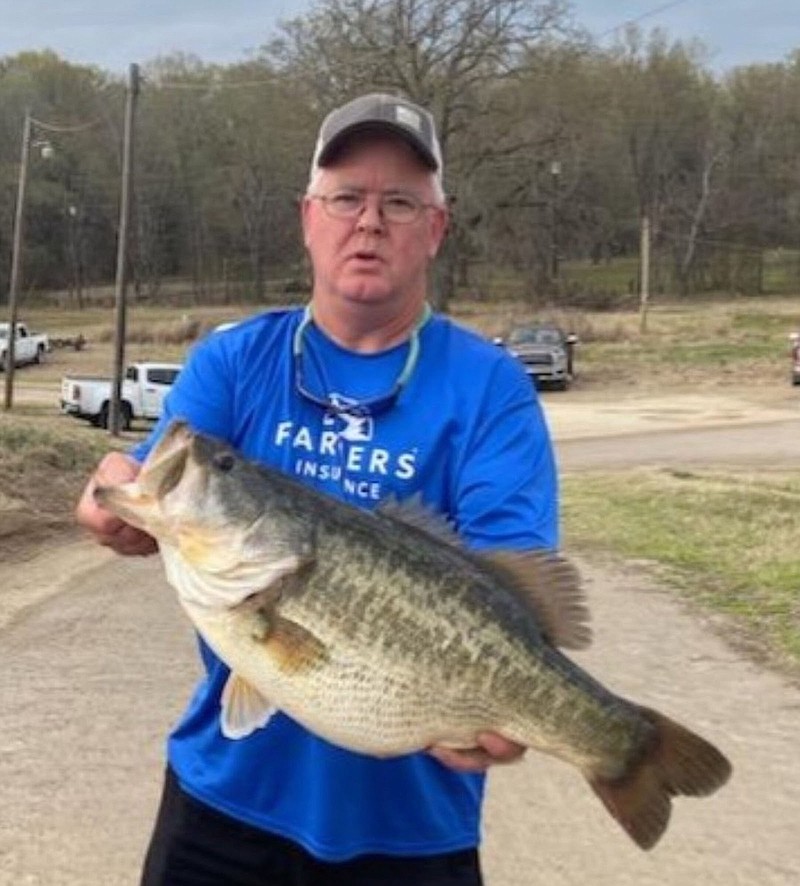Bobby Rush of Crossett recently reinforced the notion that early spring is the best time to catch monster largemouth bass.
On Feb. 26, Rush caught a Florida-strain largemouth bass weighing 15.36 pounds in Bussey Brake, a lake near Bastrop, La. Rush's bass is the new lake record for largemouth bass. It is also the second time the lake's record for bass was broken in February. It is also the eighth largest bass ever certified in Louisiana.
Bussey Brake is about five miles northwest of Bastrop. Like Lake Erling Lafayette County, Bussey Brake is a retired water supply reservoir for a paper mill. The lake served an International Paper mill that closed in 2010. International Paper had always allowed the public to fish the lake, and the company, according to the Louisiana Department of Wildlife and Fisheries, wanted it to remain open to the public. The company donated the lake and some adjacent property to the LDWF in 2013, and the agency turned it into a wildlife management area.
The area's centerpiece, of course, is 2,200-acre Bussey Brake. It has always been a high-quality fishery, but loss of habitat and the proliferation of undesirable fish species caused the bass fishery to deteriorate to mediocrity.
As the Arkansas Game and Fish Commission recently did with Lake Poinsett, the LDWF drained Bussey Brake and removed the existing fish population. During the drawdown, woody and herbaceous vegetation grew on the lake bed, providing new habitat for fish and infusing the water with nutrients when the lake refilled.
In 2017, the LDWF began stocking Bussey Brake with largemouth bass, crappie, bluegill and redear sunfish. The lake reopened for fishing in 2020, and Bobby Rush has fished it ever since.
"That thing is fertile," Rush said. "It's one of the most fertile lakes I've ever fished, and I've fished all over Arkansas and Louisiana. That thing [is] unreal!"
Rush said anglers catch bass weighing 7-11 pounds in Bussey Brake almost every day. He said anglers release most of the big fish.
"Most of them are leaving them in there," Rush said. "Let's hope they keep doing that so it doesn't turn into another (Lake) Monticello or (Lake) Columbia."
Rush said his bass was in prime pre-spawn condition. He did not see the fish before catching it.
"I went by about 45 minutes before I caught her," Rush said. "I got a bite. I'm pretty sure it was the same fish. I missed her. I made a loop around 45 minutes later and made a little different angle cast, and that time I got her."
But just barely.
"I got down to lip her," Rush said. "I'll see that hook to my dying day. She was just skin hooked. One more surge and she would have been gone."
Rush said he caught the fish flipping a 5-inch Right Bite tube jig made in Batesville. Rush would not divulge the color. He used 20-pound Seguar line and a 5/0 Gamakatsu flippin' hook. His reel was an Ambassadeur 5500 C3, an old-school round baitcaster. Rush is really proud of that. He also used a 7-foot, medium-heavy action Falcon Original rod.
Besides Bussey Brake, Rush said he often fishes Lakes Chicot and Felsenthal in Arkansas. He has spent a lot of time fishing lakes Bruin and D'Arbonne in Louisiana. He said those are great fisheries but he doesn't visit them much anymore because Bussey Brake is so good.
Crappie shock
Two weeks ago, crappie were biting in the buckbrush along the banks of Lake Ouachita, said Bill Eldridge of Benton.
Heavy rains cooled the water dramatically, causing the fish to withdraw to submerged cover in deep water, Eldridge said. Fluctuating water levels and water temperatures will disrupt the spawning pattern. You might not find crappie spawning in familiar places, but they will spawn somewhere. If you find them, you can catch them.
Stripers biting
Rusty Pruitt of Bryant and Ed Kubler of Benton recently had a great day catching stripers on the upper end of Lake Ouachita. Pruitt, who has been breaking in a new boat and learning how to use its electronic graphs, used a fly rod to catch several stripers in the 10-pound range. He said he used heavy jigs that he could cast exceptionally long distances.
